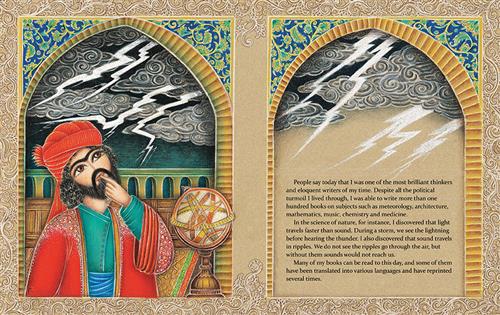The life story of Ibn Sina (980-1037), one of the greatest philosophers, scientists and physicians of the Islamic world.
Born in Persia more than a thousand years ago, Ibn Sina was one of the greatest thinkers of his time — a philosopher, scientist and physician who made significant discoveries, especially in the field of medicine, and wrote more than one hundred books.
As a child, Ibn Sina was extremely bright, a voracious reader who loved to learn and was fortunate to have the best teachers. He memorized the Qur’an by the age of ten and completed his medical studies at sixteen. He spent his life traveling, treating the sick, seeking knowledge through research, and writing about his discoveries. He came up with new theories in the fields of physics, chemistry, astronomy and education. His most famous work is The Canon of Medicine, a collection of books that were used for teaching in universities across the Islamic world and Europe for centuries.
Ibn Sina’s story, told in the first person and beautifully illustrated, provides a fascinating glimpse into the life of one of the great intellects of the past.
Correlates to the Common Core State Standards in English Language Arts:
CCSS.ELA-LITERACY.RI.4.1
Refer to details and examples in a text when explaining what the text says explicitly and when drawing inferences from the text.
CCSS.ELA-LITERACY.RI.4.3
Explain events, procedures, ideas, or concepts in a historical, scientific, or technical text, including what happened and why, based on specific information in the text.
CCSS.ELA-LITERACY.RI.5.3
Explain the relationships or interactions between two or more individuals, events, ideas, or concepts in a historical, scientific, or technical text based on specific information in the text.
The life story of Ibn Sina (980-1037), one of the greatest philosophers, scientists and physicians of the Islamic world.
Born in Persia more than a thousand years ago, Ibn Sina was one of the greatest thinkers of his time — a philosopher, scientist and physician who made significant discoveries, especially in the field of medicine, and wrote more than one hundred books.
As a child, Ibn Sina was extremely bright, a voracious reader who loved to learn and was fortunate to have the best teachers. He memorized the Qur’an by the age of ten and completed his medical studies at sixteen. He spent his life traveling, treating the sick, seeking knowledge through research, and writing about his discoveries. He came up with new theories in the fields of physics, chemistry, astronomy and education. His most famous work is The Canon of Medicine, a collection of books that were used for teaching in universities across the Islamic world and Europe for centuries.
Ibn Sina’s story, told in the first person and beautifully illustrated, provides a fascinating glimpse into the life of one of the great intellects of the past.
Correlates to the Common Core State Standards in English Language Arts:
CCSS.ELA-LITERACY.RI.4.1
Refer to details and examples in a text when explaining what the text says explicitly and when drawing inferences from the text.
CCSS.ELA-LITERACY.RI.4.3
Explain events, procedures, ideas, or concepts in a historical, scientific, or technical text, including what happened and why, based on specific information in the text.
CCSS.ELA-LITERACY.RI.5.3
Explain the relationships or interactions between two or more individuals, events, ideas, or concepts in a historical, scientific, or technical text based on specific information in the text.
| Published By | Groundwood Books Ltd — Mar 25, 2015 |
| Specifications | 32 pages | 9 in x 11.375 in |
| Keywords | history; biography; discovery and exploration; philosophy; medicine; literature; Persia; father of modern medicine; Islamic scholar; work ethic; first person narration; summarizing; determining importance; Common Core aligned; CC Literature Key Ideas and Details; grade 4; grade 5; picture book; nonfiction; map; author's note; |
| Written By | Fatima Sharafeddine is an award-winning Lebanese writer who has twice been nominated for the prestigious Astrid Lindgren Memorial Award. After receiving a B.A. in Early Childhood Education, she moved to the United States to pursue graduate studies. She now divides her time between Beirut and Brussels, where she writes and translates full time. |
| Illustrated by | Intelaq Mohammed Ali is an award-winning Iraqi illustrator, graphic designer and author, who lives in Iran. |
| Written By |
| Fatima Sharafeddine is an award-winning Lebanese writer who has twice been nominated for the prestigious Astrid Lindgren Memorial Award. After receiving a B.A. in Early Childhood Education, she moved to the United States to pursue graduate studies. She now divides her time between Beirut and Brussels, where she writes and translates full time. |
| Illustrated by |
| Intelaq Mohammed Ali is an award-winning Iraqi illustrator, graphic designer and author, who lives in Iran. |
| Audience | ages 7 to 11 / grades 2 to 6 |
| Reading Levels |
Lexile 1090L
Guided Reading Q |
| Key Text Features | map; author's note |
“Readers will learn much about his contributions to the fields of philosophy, education, and medicine.” —Publishers Weekly
“A universal celebration of curiosity and the unrelenting pursuit of knowledge.” —Brain Pickings
“The personal telling adds immediacy to this fascinating story. . . . Highly recommended.” —CM Magazine




